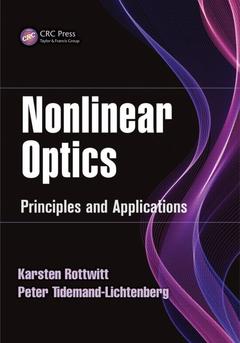Nonlinear Optics Principles and Applications Optical Sciences and Applications of Light Series
Auteurs : Rottwitt Karsten, Tidemand-Lichtenberg Peter

Explores the Fundamental Aspects of Nonlinear Optics
As nonlinear optics further develops as a field of research in electromagnetic wave propagation, its state-of-the-art technologies will continue to strongly impact real-world applications in a variety of fields useful to the practicing scientist and engineer. From basic principles to examples of applications, Nonlinear Optics: Principles and Applications effectively bridges physics and mathematics with relevant applied material for real-world use. The book progresses naturally from fundamental aspects to illustrative examples, and presents a strong theoretical foundation that equips the reader with enough knowledge to recognize, understand, and evaluate nonlinear optical phenomena.
Structured so that the first five chapters are dedicated to the description of the fundamental formalism of nonlinear optics, and the last five chapters are devoted to a description of practical devices based on nonlinear phenomena, it describes nonlinear wave propagation in bulk and in waveguiding structures, and includes specific examples of applied nonlinear wave propagation through crystals, optical waveguides, and optical fibers. Providing a theoretical description of nonlinear interaction between light and matter, this text focuses on the physical understanding of nonlinear optics, and explores optical material response functions in the time and frequency domain.
This pivotal work contains ten chapters and the main applications include:
- Optical signal processing: parametric amplification, modulators
- Transmission of optical signals: optical solitons, cross-phase modulation, four-wave mixing, phase conjugation, Raman scattering
- Sensing: temperature sensors, spectroscopy, and imaging
- Lasers: pulse compression and generation of super continuum
Nonlinear Optics: Principles and Applications
Introduction. Time-domain material response. Material response in the frequency domain, susceptibility tensors. Symmetries in nonlinear optics. The nonlinear wave equation. Second-order nonlinear effects. Raman scattering. Brillouin Scattering. Optical Kerr effect. Four wave mixing.
Karsten Rottwitt received his PhD in 1993 from the Technical University of Denmark (DTU) within propagation of solitons through optical fiber amplifiers. His Post doc was in collaboration with the femtosecond optics group, Imperial College London. From 1995 to 2000 Rottwitt continued at Bell Labs, AT&T and Lucent Technologies, New Jersey, USA. His research was directed toward Raman scattering in optical fibers. In 2000 Rottwitt moved back to Denmark where he is now at the department for photonics engineering, DTU. His research is concentrated on optical fiber nonlinearities including interactions among higher order modes, with applications within bio-photonics, sensing and communication.
Peter Tidemand-Lichtenberg
Date de parution : 01-2015
17.8x25.4 cm
Thèmes de Nonlinear Optics :
Mots-clés :
Group Velocity Dispersion; Intensity Dependent Refractive Index; Amplitude Equations; Raman Response Function; Brillouin Scattering; Raman Scattering; Coupled Wave Equations; Nonlinear Optics; Cyclic Coordinate-System; Optical Kerr Effect; Electrostriction; Refractive Index; The Born-Oppenheimer Approximation; Susceptibility Tensor; Monochromatic Fields; FOPA; The Frequency Domain; Raman Amplifier; Linear Optics; Raman Gain; Induced Polarization; Manley Rowe Relations; Harmonic Oscillator Model; Coupled Wave Theory; Nonlinear Refractive Index; Time-Domain Material Response; Spontaneous Emission; The Polarization Time-Response Function; Four Wave Mixing; Phase Matching; Fundamental Characteristics Of Silica; Quasi-phase Matching; General Theory; Parametric Amplifier; Birefringent Phase Matching; Kramers Kronig Relations; Electro Optic Effect; Soliton Period; Effective Nonlinear Coefficient



